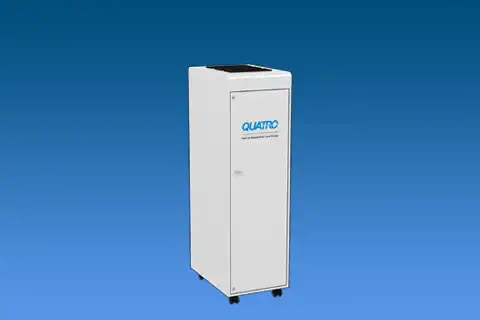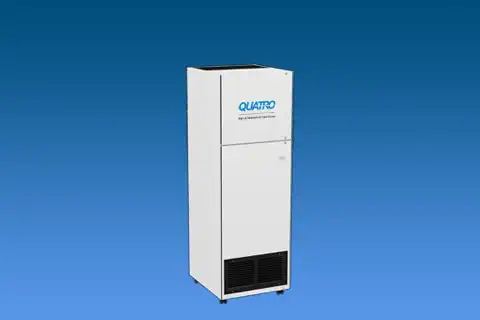Gyms & Training Centers
Overview
 While most people think of their local gym as a place to go and get fit, many gyms and training centers have serious indoor air quality (IAQ) problems that not only minimize the benefits gained through exercise, they can also negatively impact a person’s health. A 2014 study printed in Building and Environment revealed unacceptably high levels of pollutants found in most gyms throughout Europe. But North American gyms fare no better. Toxins such as volatile organic compounds (VOCs), mold, viruses and bacteria, and indoor dust and particulates commonly contaminate the air of many training centers today.
While most people think of their local gym as a place to go and get fit, many gyms and training centers have serious indoor air quality (IAQ) problems that not only minimize the benefits gained through exercise, they can also negatively impact a person’s health. A 2014 study printed in Building and Environment revealed unacceptably high levels of pollutants found in most gyms throughout Europe. But North American gyms fare no better. Toxins such as volatile organic compounds (VOCs), mold, viruses and bacteria, and indoor dust and particulates commonly contaminate the air of many training centers today.
Poor IAQ can have an even more profound impact on athletes working out. The increased rate of breathing that results from exercise not only increases carbon dioxide levels in gyms but can also lead to serious health consequences for the person working out. When an athlete breathes heavily, those airborne pollutants are inhaled faster and deeper into the lungs. In fact, a person working out takes in as much as 20 times more air than a person at rest. That means they are also taking in 20 times the level of pollutants as well.
High exposure to these toxins not only negatively impacts the performance level of athletes, but also their long-term health. Upper and lower airway dysfunction is a common problem for people who exercise in areas with poor IAQ.
Air Quality Challenges
Gyms and Training Centers face a number of challenges when trying to maintain good IAQ for the clients and staff. The major pollutants affecting the indoor air in gyms include:
- Mold
- Volatile Organic Compounds (VOC’s)
- Viruses and Bacteria
- Carbon Dioxide Levels
- Indoor Particulate and Dust
Mold
The humidity in gyms caused by clients sweating, pools, saunas, showers and even water coolers create the perfect environment for moisture to build up and for mold to take hold. Often containing mycotoxins, mold has spores which could be poisonous and can easily contaminate indoor air.
Exposure to mold, particularly through inhalation, has serious health repercussions and can lead to:
- Respiratory Issues
- Coughing
- Wheezing
- Allergic Rhinitis
- Headache
- Dizziness
- Poor concentration
- Nose Bleeds
- Rashes
The Occupational Safety and Health Association (OSHA) does not currently have standards for IAQ, but it does have regulations for contaminants affecting IAQ- mold being one of them. Gym owners can refer to the OSHA website for comprehensive guidelines on mold prevention and removal.
Volatile Organic Compounds
As much as 80% of all gyms today exceed acceptable volatile organic compound (VOC) levels. These VOCs include formaldehyde, fire retardants and acetone and are often produced by the off gassing of furniture, carpeting, gym equipment, paint and cleaners. VOC levels are higher in newer buildings or freshly cleaned spaces.
Symptoms of VOC exposure include fatigue, irritability, brain fog and eye, nose and throat irritation. Exposure to high levels of VOCs is far more dangerous and can lead to:
- Skin Irritation
- Neurotoxic effects
- Liver toxicity
- Cancer
Viruses and Bacteria
The ability of viruses to spread increases with greater numbers of people in a building. Without proper air filtration, bacteria and viruses can proliferate and linger indoors, sometimes for hours at a time. Many gyms rely solely on customers to wipe down and clean equipment which is rarely effective at eliminating unhealthy pathogens.
The spread of viruses and bacteria in gyms is further compounded by the increased rate of breathing. Installation of ventilation systems with HEPA filtration can dramatically reduce rates of infection of respiratory viruses such as COVID-19.
Carbon Dioxide Levels
IAQ is also affected by carbon dioxide levels. The higher the CO2, the lower the IAQ and the higher the risk to a person’s health.
Gyms and training centers are at particular risk of high CO2 given the number of occupants and the increased rate of breathing of its clients. Rooms with indoor cycling often show the highest level of carbon dioxide. Symptoms caused by inhaling high CO2 levels include:
- Dizziness
- Drowsiness
- Excessive Fatigue
- Headaches
- Disorientation
- Shortness of Breath
According to the American Society of Heating, Refrigerating, Air-Conditioning Engineers (ASHRAE), CO2 concentrations should be lower than 1000 parts per million (ppm) to maintain good air quality. Installing a system that both filters and ventilates air is essential to keep CO2 levels down.
The American National Standards Institute (ANSI)/ American Society of Heating, Refrigerating and Air Conditioning Engineers (ASHRAE) have guidelines for ventilation system design for acceptable IAQ. Standards 62.1 and 62.2 outline minimum ventilation rates and other measures gyms can take to curtail the adverse health effects of poor air quality.
Indoor Particulate and Dust
Yet another threat to IAQ in gyms is indoor particulate matter. A combination of solid and liquid droplets that include dust nitrates, sulfates, metals, dirt and organic chemicals, these particulates pose a serious inhalation hazard, especially if small enough to pass through nasal cavities and into lungs.
This particulate matter often comes from metal pieces banging together, chemicals from rubber mats, dust in the air and dead skin cells. To keep indoor particulates from harming clients and staff, investment in an air purifier with good quality filtration is essential.
Solutions for Gyms and Training Centers
An air purifier, with proper HEPA filtration, helps reduce airborne contaminants and improve IAQ, keeping gyms or training centers healthier places to work out.

AF 1000
HEPA Air Purifier
Enhanced protection against airborne pollutants including chemicals, gases, odors and particles. 600 nominal CFM.
Get Product Details
AF 2000
HEPA Air Purifier
Designed to handle high concentrations of chemicals, gases, odors, particles and biological contaminants. 1000 nominal CFM.
Get Product Details